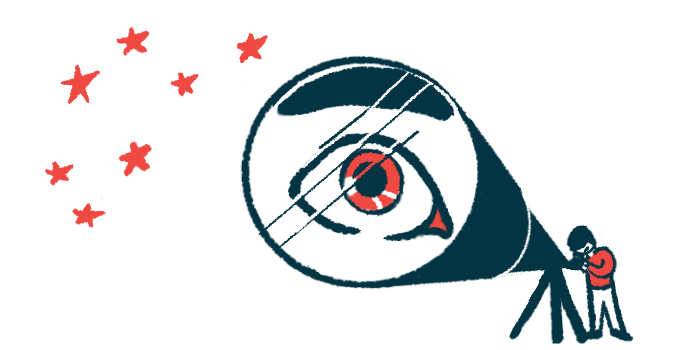Gene therapy applied as eye drops improves vision for boy with DEB
Krystal Biotech to seek FDA approval for B-VEC as DEB gene therapy for eyes
Written by |

The gene therapy beremagene geperpavec (B-VEC), applied directly as eye drops, improved the vision in a boy with eye scarring related to recessive dystrophic epidermolysis bullosa (DEB), according to a case report.
“Our data support further investigation of B-VEC in the care of patients with dystrophic epidermolysis bullosa with ocular surface involvement,” its authors wrote.
The first-of-its-kind case was described in The New England Journal of Medicine in a paper, titled “Ocular Gene Therapy in a Patient with Dystrophic Epidermolysis Bullosa.”
B-VEC uses a modified version of a herpes simplex virus (HSV-1) to deliver to cells a healthy version of the COL7A1 gene, mutations in which cause DEB. Krystal Biotech developed a gel formulation of the gene therapy designed to be applied to skin wounds called Vyjuvek, which last year made history as the first treatment for DEB to receive approval in the U.S.
Working with FDA to get B-VEC approved for DEB patients with eye lesions
“We are excited by this initial data suggesting additional applications of our proprietary HSV-1-based gene therapy platform to treat ocular diseases, and we are working with the FDA [U.S. Food and Drug Administration] to get B-VEC approved for the treatment of DEB patients with lesions in the eye,” Suma Krishnan, president of research and development at Krystal, said in a company press release.
DEB is characterized by fragile skin that easily tears and blisters. In more than one in four patients, the disease also affects the eyes, which can lead to wounds or scarring on the surface of the eye that impair vision.
“Patients with ocular complications have no corrective treatment options leaving them at risk of severe vision loss,” said Alfonso Sabater, MD, PhD, senior author of the study at the University of Miami Miller School of Medicine.
The subject of the report is a 13-year-old boy with DEB who had participated in the Phase 3 GEM-3 clinical trial (NCT04491604), one of the studies that paved the way for the approval of Vyjuvek. In the study, the boy’s skin wounds had been responding well to the gel-based gene therapy.
Since early childhood, the boy had been experiencing eye problems, including substantial scarring over the eyes. By the time his vision was deteriorating, he underwent surgeries twice to correct a fusion between the globe and the inner surface of the eyelid. However, the same issue, called a symblepharon, recurred a few months after both surgeries.
Boy had responded well to Vyjuvek for skin wounds
Because the boy had good response to Vyjuvek for skin wounds, it was proposed that B-VEC applied into his eyes might provide a more long-lasting solution to improve his vision. To facilitate this, scientists at Krystal created an eye-drop formulation of the gene therapy. After running needed preclinical testing and obtaining clearance from the FDA, the B-VEC eye drops were applied.
At the time he received the gene therapy, the patient’s vision was poor enough that he was considered legally blind. His right eye, which was more affected, had a visual acuity labelled as hand motion, which refers to testing whether or not a patient sees movement of the examiner’s hand directly in front of his eyes.
A third surgery for a symblepharon in the right eye was undertaken. Then starting immediately after the surgery, B-VEC was applied to the eyes. The gene therapy was given three times per week for the first two weeks, then weekly, for a total of 19 doses.
The boy also wore a bandage contact lens for a month after the procedure, and his eyes were treated with a steroid (to reduce inflammation) and an antibiotic (to prevent infection).
Boy’s visual acuity in right eye was 20/25 after treatment
Eight months following the procedure, the boy’s eye had healed, and the symblepharon had not recurred. The visual acuity in his right eye was measured at 20/25, which was a substantial improvement.
Over the course of follow-up, the patient experienced serious complications from a gastrointestinal surgery. While it’s impossible to say definitively that B-VEC didn’t cause these complications, the researchers said it seems unlikely the eye-applied gene therapy was related to intestinal surgery complications. The surgery complications were resolved with appropriate care, and no other major safety issues were reported.
“Larger studies and longer follow-up are needed to provide confirmation of our findings,” the team concluded.
“We are encouraged by the improvements observed in the patient following B-VEC administration as an eyedrop directly to the affected eye and believe this data is supportive of further investigation in DEB patients with ocular complications,” Sabater said. “If approved, this approach could drastically benefit these patients.”








